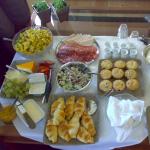They tell a joke. A man enters the hotel, sees a table bursting with food, but for some reason there are no chairs. The visitor looks around, takes a chair standing by an empty table, moves it to the one laden with food, and begins to feast. “What are you doing?” the master runs up to him. “This is a buffet!” - “When the Swedes come, I’ll get up.”
People unfamiliar with buffets are hard to imagine these days. The meaning of this ingenious, dare I say it, invention of the Swedes is that for a certain and very reasonable price (for hotel guests or cruise ship passengers it is included in the total payment) you are offered a real self-assembled tablecloth: you can take as much food as you like.
Owners of hotel complexes and other public places where there are buffets do not suffer losses, but, on the contrary, have a stable income. It seems strange: after all, the total cost of the dishes that visitors can eat significantly exceeds the conditional amount included in the credit. But the whole point is that the possibilities of eaters, even the most voracious ones, are limited. Purely physiologically. A person cannot eat more than his stomach can accommodate. Anything more will be rejected.
Today this is obvious to everyone, and therefore the “buffet” - without exaggeration - has conquered the planet. However, it is probably no coincidence that it originated in Sweden. It is closely related to the general culture of behavior that distinguishes the inhabitants of this country, including the culture of eating. This, as well as many other interesting things, is discussed in the book “Swedes and Russians: the image of a neighbor,” written by Olga Chernysheva. Doctor of Historical Sciences, employee of the Institute of General History of the Russian Academy of Sciences, she is the author of more than a hundred works on various problems in the history of Sweden, as well as other Scandinavian countries. Most of her works, well known to specialists, are strictly scientific in nature. And the new work, which has yet to take its place on bookstore shelves, became the first experience in the popular genre.
At some point,” Olga Vasilyevna told me, “I thought that it would be interesting to write just such a book, accessible and interesting to everyone, about how Russians and Swedes look at each other. And then all the scientific treatises, monographs, reports... To be honest, I got a little tired of it. I wanted to talk about ordinary life in simple, ordinary language. Moreover, Russia and Sweden are neighboring countries, connected by numerous ties that go back centuries. Mutual interest between Swedes and Russians has always existed and continues to this day. I hope that my book, covering chronologically from the 19th to the beginning of the 20th centuries, can help to understand the character of our neighbors and will be in some way instructive for today’s Russia.
And indeed it is. I lived and worked in Sweden for many years, but I read the book with enthusiasm. Moreover, it contains the opinions of many Russians, whose names are inscribed in history in golden letters.
If we return to the subject of our conversation - the “buffet”, then one of the first of our compatriots to present it to the attention of the Russian reader was K. Skalkovsky. In his notes “Travel Impressions. Among the Scandinavians and Flemings,” published in 1880 in St. Petersburg, he described this overseas miracle as follows: “Everyone demands both, the maids barely have time to uncork the bottles. There is no accounting of what is consumed here; there is a book on the table, a pencil is tied to it on a pink ribbon and everyone must write down what he ate and drank in the book. When leaving, he also sums up his account himself. It is clear that all mistakes remain on the conscience of the passenger, but the Swedes prefer to lose something better - anything rather than subjecting the traveler to humiliating controls."
It is impossible not to notice that since the quoted lines were written, the buffet model has been improved and simplified, but its noble spirit has remained.
Almost a third of a century later, the publicist and scientist S. Mech also appreciated the “buffet”, which he met in a railway buffet: “You enter the buffet - there are no servants. The barman or barmaid does not pay any attention to you. They stand on the table "There are dishes, there are plates and forks, knives and spoons. You take yourself what you want - anyway, lunch costs 2 francs. When you are full, you give 2 francs and leave."
A particularly picturesque picture was captured by the remarkable writer Alexander Kuprin, who was treated in Finland in 1909: “The long table was laden with hot dishes and cold appetizers. All this was unusually clean, appetizing and elegant. There was fresh salmon, fried trout, cold roast beef, some kind of... then game, small, very tasty meatballs, and the like. Everyone came up, chose what he liked, ate as much as he wanted, then went to the buffet and, of his own free will, paid exactly one mark thirty-seven kopecks for dinner. No supervision, no mistrust. Our Russian hearts, so deeply accustomed to the passport, the plot, the forced care of the senior janitor, to general fraud and suspicion, were completely suppressed by this broad mutual faith."
Alas, these idyllic impressions became somewhat clouded when the writer returned to the carriage, where his random fellow passengers were animatedly discussing the new product they had just become acquainted with.
“When we returned to the carriage,” writes Kuprin, “a charming picture in a truly Russian genre was waiting for us. The fact is that two stone contractors were traveling with us. Everyone knows this type of kulak from Meshchovsky district, Kaluga province: a wide, shiny, high-cheeked red muzzle, red hair curling from under a cap, a sparse beard, a roguish look, five-alty piety, ardent patriotism, and contempt for everything non-Russian - in a word, a well-known, truly Russian face.
You should have listened to how they mocked the poor Finns. “This is stupid, so stupid. After all, such fools, the devil knows them! But, if you count, I ate three rubles for seven hryvnia from them, from the scoundrels... Eh, you bastard! They don’t beat enough of them, sons of bitches. One word - Chukhons." And another one chimed in, choking with laughter: “And I... purposely knocked down the glass, and then took it into the fish and spat.” - “So they should be bastards!” his counterpart picked him up. “They dissolved anathemas! They need to be kept in check!”
Quoting these vulgar statements with anger and contempt, the author of “The Garnet Bracelet” nevertheless concludes: “And it is all the more pleasant to confirm that in this lovely, wide, semi-free country (meaning Finland. - Ed.), there is already they are beginning to understand that not all of Russia consists of contractors from Meshchovsky district and Kaluga province."
Let the reader not be confused by the mention of Finland. Being “under Sweden” until the beginning of the 19th century, this country absorbed many Swedish traditions, including the traditions of the “buffet”.
I can confirm that these traditions have been preserved in modern Sweden, as well as in Finland and Norway. To the credit of our compatriots, I have never seen anyone abroad who would rush headlong to the table, filling the plates with everything indiscriminately. Apparently, the general atmosphere of integrity that reigns in the dining room has a beneficial effect on everyone in it. Will there be a muffled exclamation from somewhere on the side: “What beauty!” Or a surprised child will exclaim: “Dad, can I take all this?!” - “Yes, son, you can.” - "And ice cream, and pineapples, and kiwi?!" - the kid doesn’t believe it right away...
The Russian people were also greatly impressed by the Swedes' deep-rooted honesty and obedience to the law, which became a national character trait. The famous Russian writer Thaddeus Bulgarin, who visited Sweden in the late 1830s, wrote: “All travelers agree about Swedish honesty, good nature and hospitality. Theft is completely unheard of here. This vile vice is disgusting even to the mob. Murders are extremely rare and happen only in fights. Throughout Sweden, a traveler is completely safe, and there is no example of a wanderer being killed or robbed, despite the fact that, when traveling in Sweden, one must pass through forests, ravines and generally sparsely populated places. The Swedes are strong in their word and deception is the greatest rarity among them ".
And what is the situation in this regard now, in our days? Unfortunately, an equally rosy picture cannot be obtained when describing modern Sweden. The bacilli of theft, rudeness, and frequent manifestations of violence against individuals, and murders have also infiltrated into this once absolutely well-bred and comfortable country. Perhaps this is the cost of Sweden’s openness to the outside world, which “gifted” them with these vices of “civilization.” And yet, even taking this into account, it must be admitted that Sweden looks better compared to most other countries.
The observations of the poet Vasily Zhukovsky, who visited Sweden as part of the retinue of the heir to the Russian throne, Tsarevich Alexander, are also very relevant for modern Russia. The attention of the poet, who was deeply interested in politics and problems of state building, was attracted, in particular, by the current constitution in Sweden. “The disadvantages of the local constitution,” Zhukovsky wrote, “... lie in the fact that amendments occur too slowly... But this slowness... is counterbalanced by the firmness of the established order. It is impossible to sacrifice the future of the state to momentary need.”
If you look from the current perspective at what attracted the poet’s attention, it should be noted that in modern Sweden any constitutional law, that is, a law aimed at changing the constitution, is considered approved only after its second adoption and by the Riksdag of a new convocation.
“Any law in Sweden,” writes Olga Chernysheva, who knows this problem well, “has long been adopted only after a long and comprehensive discussion, reflection, and calculation of all its consequences. Moreover, this discussion is conducted not only in the country’s highest legislative body, but also in the press , on television, that is, with the participation of the entire society. All this creates among the people trust in the law, confidence that the law provides for the optimal solution to any issue. It was the law that made the Swedes honest, its violation caused the greatest indignation of the Swedes at all times... This trust in the law and obedience to the law are, in fact, the core of modern Swedish society."
This also stems from the high political activity of the Swedes, who understand well that how things will develop in the state depends on their personal position.
This feature of the Swedes was very accurately noticed almost a century and a half ago by Sofya Kovalevskaya. The first woman professor of mathematics at the Stockholm Technical High School, she contributed to the high level of emancipation that exists in this country today. “Like all people with a happy past,” wrote Kovalevskaya, “the Swedes are conservative by their very nature. Any new proposal is usually met with some biased distrust... It is more difficult for a Swede to change his views, to become convinced of the inconsistency of a worldview once adopted, than for a Russian. .. But once convinced of the need for change, the Swedes do not stop halfway, do not reassure themselves with their non-participation in the common cause, but, on the contrary, consider themselves morally obligated to actually express a change in their views.”
Many interesting observations and reflections on the nature of the Swedish character are contained in the travel notes of Evgeniy Markov, who traveled around Sweden at the very end of the 19th century. He notes not only the honesty of the Swedes and their respect for the laws, but also tries to find an explanation for this. “Everywhere you meet people who are well dressed, healthy, beautiful, full of self-esteem... The local people, however, have more than one decent appearance. Everything is so legal and honest with them that you can, with a clear conscience, without any prior bargaining, rely what he will charge you for his work."
Among the many facts and thoughts contained in the book that we leafed through together, I would highlight what I consider to be the key: it was the Law that made the Swedes honest. If we, Russians, obey the laws just as scrupulously and live according to them, then we cannot escape a good life.
Buffet (buffet)- a method of serving food in which many dishes are displayed side by side, and the food is sorted into plates by the guests themselves (for example, at a buffet table). In many countries, this method of service is called pantry. Name Buffet used in Russian and several other languages (for example, Belorussian: buffet, Ukrainian: buffet style, Polish: szwedzki stół, Hungarian: svedasztal, Croatian: švedski stol).
In Scandinavian countries, however, there is a tradition of setting a cold snack table (Swedish. smörgåsbord, sandwich table, snack table) in a separate room, from which, after eating, guests move to the dining room, where they eat a traditional lunch. What is called in Russian buffet, in many other languages it is called buffet, due to a change in the meaning of a word buffet in Russian, term Buffet took his place.

Peculiarities
The buffet is a Scandinavian tradition that has been adopted throughout the world over time. Its history goes back to the distant past. Centuries ago, the Scandinavians made preparations for future use from shelf-stable products - salted fish, root vegetables and vegetables, smoked meat. When guests arrived, all the food was served at once, in large bowls. Thus, the owners saved themselves from unnecessary ceremonies, freeing up time for communication. In the 20th century, this method of collective meals was adopted by the whole world.
With self-service buffet style, there is one or more counters in the hall on which appetizers, first and second courses of fish and meat, vegetables, cheeses, and desserts are displayed in order. The guest, walking along the counter, can choose the dishes that he likes best. He can put food on the plates himself, or the waiter does it.
Varieties
There are two main types of organizing a buffet in terms of payment for the meal. The first is the most democratic option, in which you can choose a plate of any size and approach the distribution table “multiple times.” The price in this case is fixed and does not depend on the number of products taken. According to the second option, payment is made depending on the size of the plate (the so-called plate system) on which the finished dishes are placed: in a small plate, medium or large. And, in addition, payment is made for each approach.
see also
Write a review about the article "Buffet"
Notes
Links
|
||||||||||||||||||||||
Excerpt describing the Buffet
- Come on, let's go. After all, I only came to ask Denisov about yesterday's order. Got it, Denisov?- Not yet. Where are you?
“I want to teach a young man how to shoe a horse,” said Telyanin.
They went out onto the porch and into the stables. The lieutenant showed how to make a rivet and went to his room.
When Rostov returned, there was a bottle of vodka and sausage on the table. Denisov sat in front of the table and cracked pen on paper. He looked gloomily into Rostov's face.
“I am writing to her,” he said.
He leaned on the table with a pen in his hand, and, obviously delighted with the opportunity to quickly say in a word everything that he wanted to write, expressed his letter to Rostov.
“You see, dg,” he said. “We sleep until we love. We are children of pg’axa... and I fell in love - and you are God, you are pure, as on the pieties day of creation... Who else is this? Drive him to Chog’tu. There’s no time!” he shouted at Lavrushka, who, without any timidity, approached him.
- But who should be? They themselves ordered. The sergeant-major came for the money.
Denisov frowned, wanted to shout something and fell silent.
“Skveg,” but that’s the point,” he said to himself. “How much money is left in the wallet?” he asked Rostov.
“Seven new ones and three old ones.
“Oh, skveg” but! Well, why are you standing there, stuffed animals, let’s go to the sergeant,” Denisov shouted at Lavrushka.
“Please, Denisov, take my money, because I have it,” said Rostov, blushing.
“I don’t like to borrow from my own, I don’t like it,” grumbled Denisov.
“And if you don’t take money from me comradely, you will offend me. Really, I have, - repeated Rostov.
- No.
And Denisov went to the bed to get a wallet from under the pillow.
- Where did you put it, Rostov?
- Under the bottom cushion.
- Yes, no.
Denisov threw both pillows on the floor. There was no wallet.
- That's a miracle!
“Wait, didn’t you drop it?” said Rostov, picking up the pillows one at a time and shaking them out.
He threw off and brushed off the blanket. There was no wallet.
- Have I forgotten? No, I also thought that you were definitely putting a treasure under your head, ”said Rostov. - I put my wallet here. Where is he? he turned to Lavrushka.
- I didn't go in. Where they put it, there it should be.
- Not really…
- You're all right, throw it somewhere, and forget it. Look in your pockets.
“No, if I didn’t think about the treasure,” said Rostov, “otherwise I remember what I put in.”
Lavrushka rummaged through the whole bed, looked under it, under the table, rummaged through the whole room and stopped in the middle of the room. Denisov silently followed Lavrushka's movements, and when Lavrushka threw up his hands in surprise, saying that he was nowhere to be found, he looked back at Rostov.
- G "ostov, you are not a schoolboy...
Rostov felt Denisov's gaze on him, raised his eyes and at the same moment lowered them. All his blood, which had been locked up somewhere below his throat, gushed into his face and eyes. He couldn't catch his breath.
CHAPTER 1. "BUFFET"
The history of the buffet
The term "buffet" exists only in Russian. In Europe and the USA (from where democratic food formats spread), as well as in Asia (where they successfully took root), this type of service has long been called buffet (“buffet”). However, the Russian ear prefers the “buffet” option, and in support of this version there are enough arguments, historical and not so, to attribute this invention to the nation of northern seafarers.
Legend has it that even in ancient times, for large feasts, the Scandinavians prepared a lot of simple but varied shelf-stable food from salted and smoked fish and meat, boiled eggs, vegetables, mushrooms and berries, so that when new guests arrived they would not have to think about what to feed them . It is clear that it is easier to implement this idea in a cold climate and in the national cuisine that is adapted to various kinds of preparations. A few opponents of the “Swedish theory”, however, argue that this most democratic way of serving food originates from the traditional Russian meal “vodka - appetizer”. But this hypothesis does not stand up to historical criticism: democracy was not born in Russia, and the point of the buffet is not in strong drinks.
In Sweden itself, this format of serving food is called smorgasbord, that is, “sandwich table”. Sandwiches here mean any hearty food that can be prepared from anything. The presence of bread is not as important as the principle: serving dishes that are easy to eat and, unlike, for example, pasta with tomato and cheese, do not lose their taste over time.
Another idea, also closely related to the national characteristics of the inhabitants of Scandinavia, is the principle of reasonable self-restraint in the absence of control. It was he who once so impressed our compatriots who traveled abroad. Russian historian and journalist of the second half of the 19th century, Konstantin Skalkovsky, in his book “Travel Impressions,” in the chapter on the Scandinavians and Flemings, described a meal at a local inn this way: “Everyone demands both, the maids barely have time to uncork the bottles. There is no accounting of what is consumed here; There is a book on the table, a pencil is tied to it on a pink ribbon, and the guest himself is obliged to write down what he ate and drank in the book. When leaving, he also sums up his account himself. It is clear that all mistakes remain on the conscience of the passenger, but the Swedes prefer to lose something rather than subject the traveler to humiliating control.”
The writer Alexander Kuprin, who visited Finland at the beginning of the 20th century, spoke even more touchingly about the northern self-assembled tablecloth: “The long table was laden with hot dishes and cold appetizers. All this was unusually clean, appetizing and elegant. There was fresh salmon, fried trout, cold roast beef, some kind of game, small, very tasty meatballs and the like. Everyone came up, chose what he liked, ate as much as he wanted, then went to the buffet and, of his own free will, paid exactly one mark thirty-seven kopecks for dinner. No supervision, no mistrust. Our Russian hearts, so deeply accustomed to the passport, the plot, to general fraud and suspicion, were completely suppressed by this broad mutual faith.” To be fair, it should be said that in addition to noble impulses, the organizers of the “buffet” and “Finnish” tables that our travelers observed were also driven by practical considerations. This form of service was most common in restaurants and taverns located along the train route. The visitor might not have time to pay for what he ate or doubt whether it is necessary to pay for the order at all if there is no time for food. For the convenience of both guests and hosts, a wise solution was found - travelers were offered to immediately pay a fixed amount and take any number of dishes from the buffet counter.
History of the buffet
The so-called smorgasbord (snack table) was actually invented in Sweden. True, naturally modest Scandinavians do not call it Swedish. Its history goes back to the distant past. Centuries ago, the Scandinavians made preparations for future use from shelf-stable products: salted fish, root vegetables and vegetables, smoked meat. When guests arrived, all the food was served at once, in large bowls. Thus, the owners freed themselves from unnecessary ceremonies, gaining more time for communication.
This form of service was also common in restaurants and taverns located along the train route. The visitor might not have time to pay for what he ate or doubt whether it is necessary to pay for the order at all if there is no time for food.
For the convenience of guests and hosts, a wise solution was found - travelers were offered to immediately pay a fixed amount and take any number of dishes from the buffet counter. In the 20th century, this democratic way of eating was adopted by the whole world.
Buffet in tourism
The buffet form of service is very convenient for catering in hotels. This is a simple, cheap, democratic type of service provision, in which speed and practical benefit come first.
To provide such service, a minimum number of service personnel is required (one administrator to check checks or invitations, and several unskilled waiters to clear tables).
An indispensable condition for the “buffet” is the fixed time of visitors’ stay in the hall. That is why this form of service has found wide application in tourist hotels and hotels.
When paying for accommodation, a hotel client automatically pays for breakfast in the hotel restaurant. And when using a buffet, you can provide breakfast to all residents in a short period of time.
The places where the buffet is organized are all-inclusive hotels, gastronomic tours, banquets (exhibitions, business meetings, weddings and other celebrations), off-site buffets, restaurants and cafes.
The basic principle of serving a buffet in all-inclusive hotels is the presence of separate tables for salads and appetizers, for hot dishes and side dishes, pastries and desserts, as well as a table for drinks. It is possible to have specially set tables, for example - “children’s corner”, “vegetarian” or “diabetic”.
With this type of service, all dishes are served simultaneously, using special utensils and heating (cooling) devices, and, in case of long-term service (more than one hour), they must be refreshed. Special signs indicate the name of the dish (or group of dishes), their composition and some of the most important features (cold milk or hot milk).
The range of products offered may vary depending on the national characteristics of the local cuisine and the level (“star rating”) of the hotel.
Today, gastronomic tours are very popular. European countries are very interesting for such trips. Tourists are attracted by the famous wines of France, cheeses of Holland and Switzerland; many want to take a beer tour in Germany, Austria, and the Czech Republic.
Most gastronomic tours, otherwise called “tasting” tours, use a buffet system, on which one or another product is presented in portions for tasting - cheeses or meat products, chocolate or cookies, different types of wine or beer, etc.
Today, many restaurants and cafes operate partially or entirely on a buffet basis. As a rule, this can be a table of appetizers and cold salads, and in some establishments, tables with hot dishes and soups. Thanks to the buffet, it becomes possible to visually evaluate and select the dishes you like, and it also helps to save time waiting for the dishes to be served, which is important, for example, during the lunch break.
Economic expediency
The profitability of a buffet directly depends on the number of guests. The more of them gather, the higher the profit will be; an insufficient number of visitors makes this format unprofitable.
It is believed that a buffet is economically feasible if the hotel has at least 100 rooms and operates at a good occupancy for most of the year. In the low season, even in such a hotel it is unprofitable to provide a buffet breakfast, and many establishments in the three-four star category switch to a continental or expanded continental format (hot dishes are prepared according to the client’s order).
Summing up this chapter, we can highlight the basic principles of the “buffet”, if violated, its very meaning is lost:
Freedom to choose dishes, as well as the absence of any obvious restrictions on the amount of their consumption;
The fee is charged once for the entire service, access to the table for a certain time;
- the buffet is set in advance, all dishes are served immediately, and subsequently only their availability and quality are controlled;
Simplified service (each guest takes care of himself, the staff can help visitors to a greater or lesser extent, but its main task is not to serve a specific person, but to maintain order on the table).
The buffet offers the visitor:
Evaluate all available dishes without ordering them one by one and without waiting for them to be prepared and served;
There is only what you like;
Cook your own food, experimenting with ingredients, sauces, spices, and heat treatment.
The buffet is perfect for those who have difficulty communicating in a foreign language. For a person unfamiliar with local cuisine, seeing it once is better than reading, hearing, and even more so asking.
Everyone knows what a buffet is: all available treats are displayed for wide access and are constantly updated.
The dishes are convenient for quick consumption, served in large quantities so that anyone can take as much as they want.
Preliminary preparation, such as cutting up a roast carcass or chopping vegetables, has already been done.
The guest can be occupied not only with food, but also with communication.
The combination of practical considerations, freedom of choice and an element of some conviviality in this method of presentation has made this format one of the favorites in the public catering system.
Where is the buffet usually served?
Where convenience and speed are relevant, where issues of payment for food are resolved in advance, and service ceremonies are kept to a minimum.
The main niche of the buffet is hotels.
It is necessary to feed the guest in the morning, and where an independent catering network is not developed, he must also be provided with a comfortable lunch and dinner.
You need to feed the client quickly, tasty, with what he likes, and exactly when he needs it.
It is possible to adapt to the regime of a business person with a strictly scheduled schedule, a vacationer hurrying to the beach or procedure, numerous groups of tourists busy with sightseeing, only by providing them with food with simple, proven service standards and the only limitation - time.
Having paid a fixed amount, the visitor feels as free as in his own kitchen or with close friends.
He can choose any types of dishes, drinks, culinary products and fruits at his discretion, and in any order and quantity.
The objectives of a buffet in a restaurant are similar: the convenience of regular customers and attracting new guests.
With a large influx of visitors, buffets in restaurants often operate in a stable manner.
Beer bars and pizzerias have salad bars with cold dishes and snacks, and affordable cafes and fast food establishments have entire buffets offering cold, hot and desserts.
At the same time, even in expensive establishments, affordable buffet prices allow you to demonstrate the high level of cuisine and the comfort of the interior.
Having become acquainted with a restaurant in this light genre, the guest may come another time for a la carte service.
Another case where such an accessible format is simply irreplaceable is the organization of catering for large groups at various events.
The occasion, surroundings and degree of democracy can be very different.
An exquisite business buffet, in its design and the nature of the menu, will undoubtedly be distinguished from a corporate New Year's party, and that, in turn, from a picnic in nature.
But in both cases, and in the third case, the buffet will allow you to enjoy your food without focusing on the choice (after all, everything is before your eyes).
And, without adapting to field conditions, do more enjoyable things.
History and names
The term "buffet" exists only in Russian. In Europe and the USA (from where democratic food formats spread), as well as in Asia (where they successfully took root), this type of service has long been called buffet (“buffet”).However, the Russian ear prefers the “buffet” option, and in support of this version there are enough arguments, historical and not so, to attribute this invention to the nation of northern seafarers.
Legend has it that even in ancient times, for most feasts, the Scandinavians prepared a lot of simple but varied shelf-stable food from salted and smoked fish and meat, boiled eggs, vegetables, mushrooms and berries, so that when new guests arrived they would not have to think about what to feed them .
It is clear that it is easier to implement this idea in a cold climate and in the national cuisine that is adapted to various kinds of preparations.
A few opponents of the “Swedish theory”, however, argue that this most democratic way of serving food originates from the traditional Russian meal “vodka - appetizer”.
But historically, this hypothesis does not stand up to criticism: democracy was not born in Russia, and the point of the buffet is not in strong drinks.
In Sweden itself, this format of serving food is called smorgasbord, that is, “sandwich table”. Sandwiches here mean any hearty food that can be prepared from anything.
The presence of bread is not as important as the principle: serving dishes that are easy to eat and, unlike, for example, pasta with tomato and cheese, do not lose their taste over time.
Another idea, also closely related to the national characteristics of the inhabitants of Scandinavia, is the principle of reasonable self-restraint in the absence of control.
It was he who once so impressed our compatriots who traveled abroad.
Russian historian and journalist of the second half of the 19th century, Konstantin Skalkovsky, in his book “Travel Impressions,” in the chapter on the Scandinavians and Flemings, described a meal at a local inn this way: “Everyone demands both, the maids barely had time to uncork the bottles. There is no accounting of what is consumed here; There is a book on the table, a pencil is tied to it on a pink ribbon, and the guest himself is obliged to write down what he ate and drank in the book. When leaving, he also sums up his account himself. It is clear that all mistakes remain on the conscience of the passenger, but the Swedes prefer to lose something rather than subject the traveler to humiliating control.”
Writer Alexander Kuprin, who visited Finland at the beginning of the twentieth century, spoke even more touchingly about the northern self-assembled tablecloth: “The long table was laden with hot dishes and cold appetizers. All this was unusually clean, appetizing and elegant. There was fresh salmon, fried trout, cold roast beef, some kind of game, small, very tasty meatballs and the like.
Everyone came up, chose what he liked, ate as much as he wanted, then went to the buffet and, of his own free will, paid exactly one mark thirty-seven kopecks for dinner.
No supervision, no mistrust
Our Russian hearts, so deeply accustomed to the passport, the plot, the forced care of the senior janitor, to general fraud and suspicion, were completely suppressed by this broad mutual faith.”To be fair, it should be said that in addition to noble impulses, the organizers of the “buffet” and “Finnish” tables that our travelers observed were also driven by practical considerations.

This form of service was most common in restaurants and taverns located along the train route.
The visitor might not have time to pay for what he ate or doubt whether it is necessary to pay for the order at all if there is no time for food.
For the convenience of both guests and hosts, a wise solution was found - travelers were offered to immediately pay a fixed amount and take any number of dishes from the buffet counter.
Tourism development – the rebirth of the “buffet”
The rebirth of the buffet format and its worldwide popularity occurred in the 1980-1990s with the development of tourism and the penetration of democratic (or, in other words, wholesale) service schemes into all areas of everyday life.The basic principles by which the leisure industry was built arose from the needs of the mass consumer.
The average tourist, who cannot and does not want to pay a lot, but who is interested in a new country, is ready to stay in a simple room with a standard set of amenities and the same standard food.
And sometimes it’s even more prosaic - a person, tired of work, longs for complete relaxation at a resort.
He does not intend to learn a foreign language, explore local restaurants and choose something, but simply wants to get daily food and plenty of beer or cola for his money.
To satisfy these simple needs, all inclusive was invented - a standard holiday on the hotel premises, in which food is one of the main entertainments.
With the development of similar hotel conglomerates in Turkey, for example, the small restaurant business in the coastal zone was practically destroyed.
Now a similar process is underway in Greece, which confirms the general rule: a country focused on affordable mass tourism pays for profits with the loss of its own individuality, at least in the most popular tourist areas.
However, the rapid development of large chain hotels and the steady demand for their services are associated with trust in the brand. Only a reputable player can offer a unified, not always the best, but stable standard of quality.
This point is not so important in Europe, where travelers, avoiding the beaten tourist path, look for small family hotels and restaurants where they can take a break from civilization.
Nevertheless, it is the quality guarantee that becomes relevant in southern and exotic countries. No one knows what to expect from unusual food prepared from specific ingredients and sometimes in questionable sanitary conditions.
It is not clear who to complain to if the memory of a local meal turns out to be too long.

Therefore, for a European who is cautiously exploring a foreign country, a large hotel will always serve a familiar table with adapted elements of local cuisine.
And let him not know all the charm of real candied butterflies, safety and reliability are above all.
After all, the company is responsible for the food that is offered to him at the hotel, risking its reputation.


















